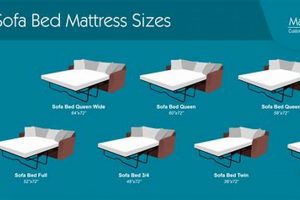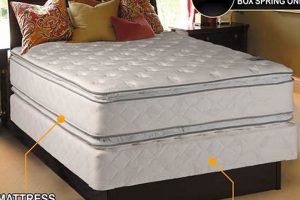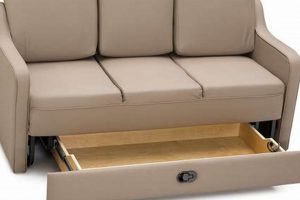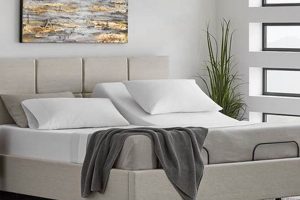A sleeping surface designed for a wall bed mechanism is typically thinner and lighter than standard innerspring mattresses. Its dimensions conform to standardized measurements established for queen-size bedding, approximately 60 inches wide and 80 inches long. This specification ensures compatibility with the folding frame inherent to wall bed systems, facilitating seamless retraction and deployment.
The selection of an appropriate support is crucial for maximizing space utilization and ensuring comfortable rest within confined living spaces. Its integration contributes to multi-functional room design, offering a practical solution for accommodating guests or creating flexible living areas. The evolution of such specialized bedding reflects increasing demand for efficient space-saving solutions in contemporary residential environments.
The following sections will delve into key considerations for selecting a suitable sleeping solution for wall beds, including material composition, thickness limitations, weight restrictions, and specific features that enhance both comfort and functionality.
Selecting a Mattress for a Wall Bed
Proper selection is critical to the functionality and longevity of a wall bed system. Compatibility with the folding mechanism is paramount. The following recommendations provide guidance for informed decision-making.
Tip 1: Adhere to Thickness Restrictions. Exceeding the manufacturer’s specified depth can impede closure and potentially damage the frame. Consult the wall bed’s documentation to ascertain maximum permissible thickness.
Tip 2: Consider Weight Limitations. Excessive weight can strain the lifting mechanism, accelerating wear and tear. Ensure the chosen bedding falls within the load-bearing capacity of the bed frame.
Tip 3: Prioritize Low-Profile Designs. Mattresses with minimal height allow for a more streamlined appearance when stowed, preserving valuable floor space.
Tip 4: Explore Material Options. Memory foam and latex constructions often provide a balance of comfort and compressibility, making them suitable choices for folding beds.
Tip 5: Evaluate Edge Support. Adequate edge support is important for maintaining structural integrity and preventing sagging, especially in beds that are frequently folded and unfolded.
Tip 6: Seek Firmness. The firmness level should align with individual sleep preferences, but a medium-firm construction generally offers optimal support for a range of body types.
Tip 7: Verify Compatibility. Confirm that the selected product conforms to standard queen-size dimensions to guarantee a proper fit within the wall bed frame.
Careful attention to these factors will optimize the performance of a wall bed and ensure years of reliable service.
The subsequent section will explore common issues encountered with the product, along with troubleshooting techniques.
1. Thickness limitation
The thickness limitation inherent in wall bed designs represents a critical factor when selecting a queen-sized sleeping surface. Wall beds, by their nature, must fold into a cabinet or recess. Consequently, there is a finite amount of space allocated for the bedding when the unit is in the stowed position. Exceeding the manufacturer’s specified maximum thickness can prevent the bed from closing completely, potentially damaging the frame, hinges, or locking mechanisms. For example, a Murphy bed designed to accommodate a 10-inch thick support will experience closure difficulties if a 12-inch thick version is used, forcing undue stress on the system. This physical constraint necessitates careful measurement and adherence to product specifications.
The implications of disregarding thickness constraints extend beyond mere inconvenience. Repeated attempts to force a too-thick bedding into a closed wall bed can lead to structural damage, rendering the unit unusable and necessitating costly repairs. Furthermore, an improperly closed bed poses a safety hazard, as it may not be securely latched, increasing the risk of unexpected deployment. Consider a scenario where a poorly chosen bedding causes the frame to warp over time. This warping could ultimately compromise the bed’s structural integrity, leading to failure under load.
In summary, thickness limitation is not simply a technical detail but a fundamental requirement for the proper functioning and safe operation of a queen-sized sleeping surface designed for a folding wall bed. Adhering to specified dimensions prevents mechanical damage, ensures secure closure, and safeguards against potential hazards. Therefore, thorough research and accurate measurements are essential steps in the selection process.
2. Weight capacity
The weight capacity of a wall bed system is a critical design parameter directly impacting the selection of a queen-sized sleeping surface. This specification dictates the maximum load the lifting mechanism and frame can safely support, encompassing not only the weight of the bedding but also the weight of the occupants. Exceeding this limit can compromise the structural integrity of the bed, potentially leading to mechanical failure, difficulty in operation, or, in extreme cases, collapse. For instance, a wall bed with a rated weight capacity of 500 pounds should not be paired with a sleeping surface weighing 150 pounds if the intended occupants collectively weigh 400 pounds, as this would exceed the safe operating threshold. Therefore, careful calculation and adherence to the manufacturer’s weight restrictions are paramount.
The implications of overloading a wall bed extend beyond the immediate risk of structural failure. Repeatedly exceeding the weight capacity can accelerate wear and tear on the lifting mechanism, reducing its lifespan and potentially voiding warranties. Furthermore, an overloaded bed may become difficult to operate, requiring excessive force to raise or lower, increasing the risk of injury. Consider a scenario where a wall bed’s lifting mechanism is progressively weakened by exceeding the rated capacity. Over time, this weakening could result in the sudden and uncontrolled descent of the bed, posing a significant safety hazard to anyone in the vicinity. The choice of material also affects weight: a heavy innerspring queen-sized mattress puts more stress on the system compared to a lighter foam one.
In conclusion, understanding and respecting the weight capacity of a wall bed is essential for ensuring safe and reliable operation. Careful consideration must be given to the combined weight of the selected queen-sized sleeping surface and the intended occupants. Exceeding this limit not only jeopardizes the structural integrity of the bed but also poses a significant safety risk. Therefore, thorough research, accurate measurements, and adherence to manufacturer specifications are crucial for selecting an appropriate solution.
3. Material composition
The material composition of a queen mattress significantly influences its suitability for use within a Murphy bed system. The characteristics of different materials directly impact the mattress’s weight, flexibility, and overall durability, all critical factors for proper Murphy bed functionality. For instance, innerspring mattresses, while potentially providing robust support, often exhibit greater weight and reduced flexibility compared to foam alternatives, potentially straining the Murphy bed’s lifting mechanism and hindering smooth operation. Conversely, memory foam or latex options may offer a lighter weight and improved compressibility, facilitating easier folding and stowage within the system. A heavier mattress would also require a stronger (and potentially more expensive) lifting mechanism in the Murphy bed frame itself.
The choice of materials also impacts the long-term performance and comfort of the sleeping surface. While innerspring mattresses are known for breathability, their lack of flexibility can lead to uneven wear and potential damage when repeatedly folded and unfolded. Memory foam, conversely, may retain heat, but its ability to conform to the body provides pressure relief and potentially increased comfort. Hybrid designs, incorporating both innerspring and foam layers, attempt to balance these competing characteristics. The selection process necessitates careful consideration of these trade-offs, taking into account individual comfort preferences and the specific requirements of the Murphy bed frame. For example, a denser foam structure would provide improved resistance to wear from repeated folding and unfolding, compared to a less dense material.
In summary, material composition is not merely a matter of comfort preference but a crucial determinant of a queen mattress’s compatibility with a Murphy bed. Weight, flexibility, durability, and thermal properties all play a role in ensuring the smooth operation, longevity, and comfort of the combined system. Therefore, careful evaluation of material characteristics is essential for maximizing the benefits of a space-saving Murphy bed design. The consideration of material composition also has significant cost implications; higher-quality materials generally translate to a more durable and comfortable mattress, but also a higher upfront investment.
4. Folding mechanism
The folding mechanism is integral to the functionality of a Murphy bed. Its design and operational characteristics directly influence the selection criteria for a compatible queen-sized sleeping surface. The interaction between these two components dictates ease of use, long-term reliability, and the overall space-saving efficiency of the system.
- Spring or Piston System Influence
The type of lifting system, whether employing springs or pistons, dictates the permissible weight range of the bedding. Spring-based mechanisms often require a specific weight to function correctly; too light, and the bed may not stay down, too heavy, and it becomes difficult to lift. Piston systems generally offer a wider weight tolerance, but still have limits that must be adhered to. The weight of the queen mattress must be within the operational parameters of the chosen mechanism type to ensure smooth and safe operation.
- Frame Clearance Requirements
The frame design of the folding mechanism dictates the maximum thickness that can be accommodated. Complex mechanisms with multiple pivot points may have stricter limitations on depth compared to simpler designs. This dimension directly influences the types of bedding that can be used; thicker, more luxurious options may be incompatible with certain folding mechanisms. Accurate measurements of the frame’s clearance are essential prior to mattress selection.
- Locking and Safety Features
The reliability of the locking mechanism is paramount for safety. The added weight of an unsuitable queen mattress can compromise the effectiveness of these safety features. Overloading the mechanism can strain the locking components, increasing the risk of unintended deployment. The chosen sleeping surface must conform to the manufacturer’s specifications to ensure that the locking system functions as intended, preventing potential hazards.
- Durability and Longevity
Repeated use of the folding mechanism exerts stress on all its components. The weight and rigidity of the queen mattress contribute to this stress. A heavier or less flexible sleeping surface can accelerate wear and tear on the hinges, springs, or pistons, reducing the lifespan of the entire system. Selecting a lighter, more pliable mattress that conforms to the mechanism’s specifications can enhance its durability and extend its operational life.
These facets highlight the critical interplay between the folding mechanism and the selection of a suitable queen mattress. Choosing a sleeping surface that aligns with the mechanism’s design parameters is crucial for optimizing performance, ensuring safety, and maximizing the lifespan of the complete Murphy bed system. Disregarding these considerations can lead to operational difficulties, safety hazards, and premature failure of the mechanism. Material science, weight distribution and other criteria will also affect folding mechanism for the queen mattress of Murphy bed.
5. Size compatibility
Precise size compatibility constitutes a foundational requirement for integrating a queen mattress within a Murphy bed system. Dimensional discrepancies, even seemingly minor ones, can lead to significant operational impediments. A queen mattress exceeding the specified width or length of the Murphy bed frame will prevent proper closure, rendering the space-saving functionality of the system inoperable. Conversely, a mattress significantly smaller than the designated dimensions will shift within the frame, compromising support and comfort, and potentially creating a safety hazard. The standardized dimensions of a queen mattress, nominally 60 inches wide and 80 inches long, serve as the benchmark against which the internal dimensions of the Murphy bed frame must be meticulously aligned.
The practical significance of adhering to size compatibility extends beyond mere functionality. A properly fitted mattress ensures even weight distribution across the Murphy bed frame, minimizing stress on the lifting mechanism and extending its lifespan. Moreover, a secure fit prevents the mattress from shifting during use, maintaining a stable and comfortable sleeping surface. In a real-world example, consider a Murphy bed designed for a standard queen size mattress. If an owner attempts to use a slightly oversized mattress, the force required to close the unit may damage the frame or the locking mechanism. This could result in costly repairs and compromise the safety of the system. The size compatiability also affects storage and portability.
In summary, size compatibility represents a non-negotiable element in the successful integration of a queen mattress within a Murphy bed. Deviation from specified dimensions undermines the system’s functionality, compromises safety, and reduces its lifespan. Accurate measu
rement and adherence to manufacturer specifications are essential to realize the intended benefits of this space-saving design. Attention should be paid for size and dimension to achieve its purpose.
6. Comfort level
The subjective experience of comfort, while inherently personal, remains a critical factor in selecting a queen mattress for a Murphy bed. A balance must be struck between individual preferences and the practical limitations imposed by the Murphy bed’s design.
- Firmness and Support
Firmness dictates the degree to which the mattress yields under pressure, while support refers to its ability to maintain spinal alignment. A mattress too soft may lead to discomfort and back pain, while one too firm may cause pressure points. The optimal firmness level is contingent upon individual sleeping position and body weight. A side sleeper, for example, typically benefits from a softer mattress that conforms to the contours of the body, while a back sleeper often requires a firmer surface to maintain spinal stability. For a queen-sized mattress in a Murphy bed, this selection is even more critical, as space constraints limit the ability to add toppers or adjust the sleeping surface after installation.
- Material and Temperature Regulation
Mattress materials significantly influence temperature regulation during sleep. Memory foam, while conforming closely to the body, is known for retaining heat, potentially leading to discomfort for individuals prone to overheating. Latex and innerspring mattresses, conversely, often offer better breathability and heat dissipation. The choice of material should be informed by the sleeper’s thermal preferences and the ambient temperature of the room in which the Murphy bed is located. A mattress with cooling properties might be particularly beneficial in warmer climates or for individuals who tend to sleep hot.
- Pressure Relief
Pressure relief refers to the mattress’s ability to minimize pressure points, particularly in the shoulders, hips, and knees. Adequate pressure relief is essential for promoting circulation and preventing discomfort during sleep. Memory foam and latex mattresses are generally recognized for their superior pressure-relieving properties compared to traditional innerspring models. However, the effectiveness of pressure relief also depends on the firmness level of the mattress and the sleeper’s body weight. A mattress that does not provide adequate pressure relief can lead to restless sleep and exacerbate existing joint pain.
- Motion Isolation
Motion isolation refers to the mattress’s ability to minimize the transfer of movement from one side of the bed to the other. This is particularly important for couples sharing a queen mattress, as it prevents disturbances caused by one partner’s movements from affecting the other. Memory foam and pocketed coil mattresses generally excel at motion isolation, while traditional innerspring mattresses tend to exhibit greater motion transfer. The degree of motion isolation required depends on the sensitivity of the sleepers and their individual sleep habits.
The subjective nature of comfort necessitates careful consideration of individual needs and preferences when selecting a queen mattress for a Murphy bed. Balancing these factors with the practical constraints of the Murphy bed system is essential for creating a comfortable and functional sleeping environment. Compromises may be necessary to accommodate the space-saving design, but prioritizing key comfort factors can significantly enhance the overall sleep experience.
7. Storage needs
Storage needs, when considered in conjunction with a queen mattress for a Murphy bed, represent a critical design consideration. The integration of sleeping arrangements into limited spaces necessitates careful planning to ensure both comfort and efficient use of available area. The interplay between these two factors the size of the sleeping surface and the surrounding storage solutions directly impacts the functionality and practicality of the overall living environment.
- Clearance around the Murphy Bed Cabinet
The space surrounding the Murphy bed cabinet must be sufficient to allow for the unencumbered deployment of the queen mattress. Existing furniture or storage units positioned too closely can obstruct the bed’s unfolding, negating its space-saving benefits. Prior assessment of the room’s dimensions, coupled with accurate measurements of the Murphy bed’s operational footprint, is essential to avoid such obstructions. A scenario where bookshelves are positioned directly in front of a Murphy bed would render the bed unusable without first moving the bookshelves.
- Storage Within the Murphy Bed Cabinet
Many Murphy bed designs incorporate integrated storage solutions within the cabinet itself. These may include shelving, drawers, or compartments intended for storing bedding, pillows, or personal items. The capacity and configuration of this internal storage should align with the user’s storage requirements, ensuring that essential items are readily accessible when the bed is in use. For example, a Murphy bed with shallow shelves may not be suitable for storing bulky comforters, necessitating alternative storage arrangements.
- Accessibility to Existing Storage
The installation of a Murphy bed should not impede access to existing storage areas within the room. Positioning the bed in a manner that blocks closets, drawers, or cabinets diminishes the overall utility of the space. Careful consideration of the room’s layout and traffic patterns is necessary to maintain accessibility to all storage areas. A Murphy bed placed directly in front of a closet door would prevent access to the closet when the bed is deployed.
- Temporary Storage During Bed Deployment
When the Murphy bed is deployed, temporary storage solutions may be required for items that are displaced or relocated to create space. This could involve portable storage containers, folding tables, or designated areas for temporarily stowing items such as lamps, decorative objects, or small pieces of furniture. Planning for these temporary storage needs is crucial for maintaining order and functionality within the room. For instance, a folding side table could provide a surface for a reading lamp when the bed is in use, and then be easily stored when the bed is stowed away.
The successful integration of a queen mattress into a Murphy bed system hinges upon a holistic consideration of storage needs. Clearance around the cabinet, integrated storage within the cabinet, accessibility to existing storage, and temporary storage during bed deployment all contribute to the overall functionality and usability of the space. By carefully addressing these factors, a Murphy bed can serve as an effective space-saving solution without compromising storage capacity or accessibility.
Frequently Asked Questions
This section addresses common inquiries regarding the selection and usage of a queen mattress in conjunction with a Murphy bed system, providing objective information to aid in informed decision-making.
Question 1: What is the maximum permissible thickness for a queen mattress used in a Murphy bed?
The maximum permissible thickness varies depending on the specific M
urphy bed model. Consult the manufacturer’s specifications to determine the appropriate dimensions. Exceeding the stated thickness can impede closure and potentially damage the folding mechanism.
Question 2: Does the weight of the queen mattress affect the operation of the Murphy bed?
Yes, the weight of the queen mattress is a critical factor. Each Murphy bed system has a specified weight capacity. Selecting a mattress that exceeds this limit can strain the lifting mechanism and compromise its functionality.
Question 3: Are all queen mattresses compatible with all Murphy beds?
No, compatibility is not guaranteed. Factors such as thickness, weight, and material composition must be considered. It is essential to verify that the chosen queen mattress meets the specific requirements of the Murphy bed frame.
Question 4: What type of queen mattress is best suited for a Murphy bed?
Low-profile memory foam or latex mattresses are often recommended due to their lighter weight and flexibility. These materials tend to be more easily compressed, facilitating smoother operation of the Murphy bed mechanism.
Question 5: Can a standard queen mattress be used with a Murphy bed?
While a standard queen mattress may fit within the Murphy bed frame, it is crucial to verify that its thickness and weight are within the specified limits. Standard mattresses are often thicker and heavier than those designed specifically for Murphy beds.
Question 6: How does the firmness of the queen mattress affect the functionality of the Murphy bed?
The firmness level does not directly impact the mechanical operation of the Murphy bed. However, a mattress that is excessively firm or soft may be more difficult to fold and stow, potentially affecting the ease of use.
Careful consideration of these factors is essential for ensuring the optimal performance and longevity of a queen mattress within a Murphy bed system. Consulting the manufacturer’s guidelines and specifications is strongly recommended.
The next section will provide troubleshooting tips for common issues encountered with a queen mattress in a Murphy bed.
Conclusion
The preceding discussion has elucidated the critical factors governing the successful integration of a queen mattress for murphy bed applications. Key considerations encompass dimensional compatibility, weight limitations, material properties, and the specific mechanics of the folding mechanism. Neglecting these parameters can compromise functionality, safety, and the longevity of both the mattress and the murphy bed system.
Therefore, adherence to manufacturer specifications and careful evaluation of individual needs are paramount. A properly selected and maintained queen mattress for murphy bed configuration offers a practical solution for optimizing space without sacrificing comfort. Future advancements in material science and folding mechanism design may further enhance the performance and versatility of these systems, solidifying their role in efficient and adaptable living spaces. Continued research and development will be crucial to meeting the evolving demands of space-conscious consumers.






![Best Blow Up Mattress for Sofa Bed [Guide & Reviews] Organic & Natural Mattress Buyer’s Guide: Non-Toxic Sleep Solutions Best Blow Up Mattress for Sofa Bed [Guide & Reviews] | Organic & Natural Mattress Buyer’s Guide: Non-Toxic Sleep Solutions](https://mattressworldpa.com/wp-content/uploads/2025/07/th-7138-300x200.jpg)
